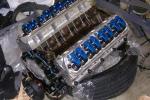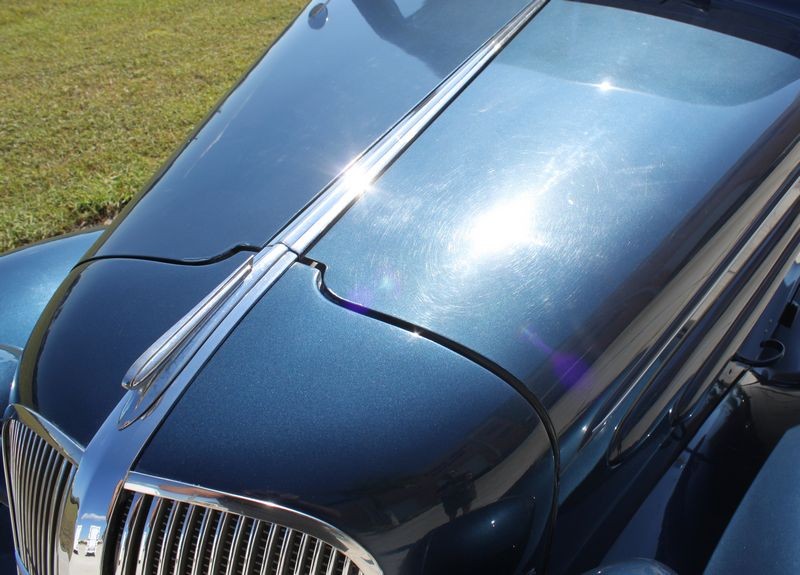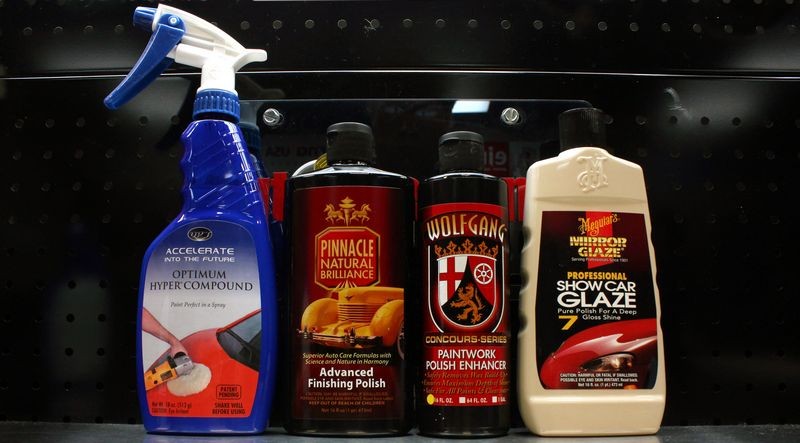 Thanks: 0
 Likes: 0
 Dislikes: 0
-
Junior Member

New paint care - type of glaze to use
Mike, I am currently having a project/show car Mustang built and painted a gorgeous medium blue metallic. Since it usually takes 30 days or so (longer now bc it's winter) for the paint to cure, I am wondering what products I can use (glaze and wash) since waxes are not recommended at first. I am getting a free sample of the wolfgang glaze with a recent purchase, but I wanted to see what products you recommend for new paint and do they offer any protection? Are certain products on the AG website better than others i.e. blackfire, wolfgang, detailers pride etc. I am new to the detailing world, but I just received my griots garage DA from you guys tonight! Thanks for the help and advice.
John
-
Super Member

Re: New paint care - type of glaze to use
3M Imperial Hand Glaze
Meg's #7

Bob
"Be wary of the man who urges an action in which he himself incurs no risk."
~Joaquin de Setanti
-
Junior Member

Re: New paint care - type of glaze to use
Thanks! Glazes don't have any protective properties do they? If they don't more reason why the newly painted car should be in the garage over the winter months!!!
-
Super Member

Re: New paint care - type of glaze to use
 Originally Posted by 93Mustang

Thanks! Glazes don't have any protective properties do they? If they don't more reason why the newly painted car should be in the garage over the winter months!!!
You're preaching to the choir, Brother!!

Bob
"Be wary of the man who urges an action in which he himself incurs no risk."
~Joaquin de Setanti
-
Super Member

Re: New paint care - type of glaze to use
Megs #7 is a PIA to work with.
-
Super Member

The Wolfgang Glaze is actually a polish, not a traditional glaze. I like Poor Boys Black Hole or Wet Glaze 2.0
-
Junior Member

Re: New paint care - type of glaze to use
Great, I'll look into those options. Thanks guys
-
-
Re: New paint care - type of glaze to use
 Originally Posted by 93Mustang

Mike, I am currently having a project/show car Mustang built and painted a gorgeous medium blue metallic. Since it usually takes 30 days or so (longer now bc it's winter) for the paint to cure, I am wondering what products I can use (glaze and wash) since waxes are not recommended at first.
Historically you would use a NON-abrasive pure polish. In the U.S. that's predominantly been Meguiar's #7 Show Car Glaze or 3M Imperial Hand Glaze.
You will get people arguing over what a "glaze" is but again, historically, a glaze is first a body shop product, not a consumer product or even a detailing product.
We painted cars long before detailing was ever started...
I cover this in my how-to book and in my article here, again, this can be found on my article list...
Word Definitions - Compounds, Polishes, Glazes, Paint Cleaners and Waxes
There's always a lot of confusion when it comes to words and terms used in the car detailing industry and hobby.
Part of the reason for this is because there's no organization in the auto appearance industry that regulates or has oversight over the language used to describe and market car appearance products. Manufactures, marketers and distributors of car care appearance products can and do name their products using whatever terms they like regardless of the confusion it may cause or any historical precedents.
Judge a product by the function it performs, not the name on the label
Because there's no universal or industry accepted standards for definitions for words and terms used in the car care appearance world, my practice and recommendation to others is to judge a product not by the name on the label but by what function the product serves.
For example if a product is referred to as a polish but acts as a paint sealant, then the product is in fact a paint sealant and not an abrasive polish in the historical use of the word.
If a product is referred to as a glaze but acts to seal the paint with some type of water insoluble paint protection ingredients, then the product is a wax or a paint sealant or some hybrid variation of a wax or paint sealant and not a glaze in the historical use of the word.
Here's a list of commonly used words in our industry and my attempt at creating some type of standardized definition for each word.
Aggressive Cut Compound
Medium Cut Polish
Fine Cut Polish
Ultra Fine Cut Polish
Non-Abrasive Glaze or Pure Polish
Pre-Wax Cleaner
Paint Cleaner
Carnauba Wax
Synthetic Paint Sealant
Hybrid Sealant/Wax
Paint Coating
Cleaner/Wax or AIO
Below are some descriptions for each category.
Aggressive Cut Compound
A very aggressive liquid or paste that uses some type of abrasive technology to cut or abrade paint quickly. In the body shop world, compounds are used to remove sanding marks. In the detailing world, compounds are used to remove deep below surface defects like swirls, scratches and water spot etchings. Depending upon the abrasive technology and the application method and material, some automotive compounds can remove down to #1000 grit sanding marks. Of course topcoat hardness is an important factor that affects compound effectiveness at removing below surface defects.
Historically, the more aggressive the compound, the more follow-up polishing will be required to restore a defect-free finish. Due to major advancements in abrasive technology, the trend is for very aggressive compounds that finish out like medium and even fine polishes.
In most cases an aggressive compound should be followed with either a medium polish or a fine polish to refine the surface to a higher degree of finish quality than the results produced by only the compound. Most compounds are dedicated products in that their function is primarily to abrade the paint. For this reason, after the compounding step further polishing and then sealing steps are required. Most compounds are water-soluble so that they can be washed, (dissolved with water and soap), off body panels and out of cracks and crevices.
Medium Cut Polish
A liquid or paste that uses some type of abrasive technology to cut or abrade the paint but is less aggressive than a true cutting compound. Depending upon the abrasive technology and the application method and material, some medium polishes can remove down to #2000 grit sanding marks and finish out to LSP ready. Topcoat hardness is an important factor that affects a medium polish's effectiveness at removing below surface defects.
Most medium polishes are dedicated products in that their function is primarily to abrade the paint. For this reason, after the polishing step further steps are required, which may include another final polishing step depending upon the results after using the medium polish and the expectations by the user for the end results. At a minimum, the paint should be sealed with a wax, paint sealant or coating.
Fine Cut Polish
A liquid or paste that uses some type of abrasive technology to cut or abrade the paint but is less aggressive than a true medium polish. Depending upon the abrasive technology and the application method and material, some fine polishes can remove down to #2500 grit sanding marks while still finishing out LSP ready. Topcoat hardness is an important factor that affects a fine polish's effectiveness at removing below surface defects.
Most fine polishes are dedicated products in that their function is primarily to abrade the paint. For this reason, after the fine polishing step further steps may be required. This could include another final polishing step depending upon the results after using the fine polish and the expectations by the user for the end results. At a minimum, the paint should be sealed with a wax, paint sealant or coating.
Ultra Fine Cut Polish
A liquid or paste that uses some type of abrasive technology to cut or abrade the paint but is less aggressive than a true fine polish. Depending upon the abrasive technology and the application method and material, some ultra fine polishes can remove down to #2500 grit sanding marks while still finishing out LSP ready. Topcoat hardness is an important factor that affects an ultra fine polish's effectiveness at removing below surface defects.
Most ultra fine polishes are dedicated products in that their function is primarily to abrade the paint. For this reason, after the ultra fine polishing step at a minimum, the paint should be sealed with a wax, paint sealant or coating.
Non-Abrasive Glaze or Pure Polish
Historically, the term glaze is used to describe a bodyshop safe, hand-applied liquid used to fill-in and mask fine swirls while creating a deep, wet shine on fresh paint. It's a category of products used on fresh paint in body shop environments, which will not seal the paint surface by depositing a long lasting sacrificial barrier coating using some type of protection ingredients.
A bodyshop safe glaze is used in place of a wax, sealant or coating because it won't interfere with the normal out-gassing process of fresh paint for the first 30 days of curing. The function of a bodyshop glaze is to hide rotary buffer swirls while giving the paint a uniform, just waxed appearance to ensure customer satisfaction. After 30 days cure time its normal to the seal the paint using a wax, paint sealant or coating.
Hiding Swirls
There's a number of reasons why historically body shops use a glaze on fresh paint to hide swirls. Most body shops are production oriented and perform a limited number of machine buffing steps due to time restrictions and profitability. This would include machine compounding with a wool pad and machine polishing with either a wool finishing pad or a foam polishing or finishing pad, both steps using rotary buffers.
The end results are normally excellent shine but with rotary buffer swirls in the paint, (also called holograms and/or rotary buffer trails), that can be seen in bright light. The glaze is normally hand-applied to fill-in and hide the swirls as hand application is fast and relatively effective as long as the swirls are shallow. This glazing procedure produces a finish that customers will accept at the time of vehicle pick-up. The results are somewhat misleading however because bodyshop glazes are water soluble and as such will wash off after a few car washes or repeated exposure to rainy weather and then the swirls will become visible. This is the standard and accepted practice in the body shop industry.
Note: Because there are no rules or regulations governing the definition or the use of the word glaze, manufactures and sellers of paint care products use the word glaze as a name for all types of products that are not true glazes in the historical sense of the word. Most common is the use of the word glaze in the name of a car wax or paint sealant.
Paint Cleaner
A liquid, paste or cream that relies primarily on chemical cleaning agents to remove any light topical contamination or surface impurities to restore a clean, smooth surface as part of a process to prepare a painted finish for application of a wax, paint sealant or coating. Paint cleaners are for very light cleaning and not normally intended to be used like an abrasive polish to remove below surface defects.
Pre-Wax Cleaner
Similar or the same as a paint cleaner. Most pre-wax cleaners are complimentary products in that they are part of a specific brand's system in which the pre-wax cleaner is matched to a wax or paint sealant. There's a chemical synergistic compatibility to ensure maximum performance between products that might not be achieved using products from outside the brand. (only the chemist would know)
Carnauba Car Wax
Generally defined or at least thought of by the masses as a product that contains some type of naturally occurring waxy substance intended to protect the paint while creating a clear, glossy finish. Carnauba wax is the most commonly used naturally occurring wax found in car wax formulations. This category of traditional waxes will wear off under normal wear-n-tear, repeated washings and exposure to the environment and should be reapplied on a regular basis to maintain a protective coating on the surface of the paint.
Synthetic Paint Sealant
Generally defined as, or thought of by the masses, as a product that contains some type of man-made or synthetic protection ingredients to protect the paint while creating a clear, glossy finish. Perception on the part of the public is that a paint sealant is made from synthetic polymers with no naturally occurring wax type substance or other naturally occurring protection ingredients.
General consensus among car enthusiasts is that because the protection ingredients are synthetic, a paint sealant will protect better and last longer than a traditional car wax made using naturally occurring waxes. Paint sealants will wear off under normal wear-n-tear, repeated washings and exposure to the environment and should be reapplied on a regular basis to maintain a protective coating on the surface of the paint.
Hybrid Sealant/Wax
Even though most people think that the words car wax refers to a category of products that uses naturally occurring wax ingredients for protection and beauty and paint sealant refers to a category of products that uses synthetic polymers for protection and beauty, the fact is most products are a blend of both natural and synthetic ingredients and are thus hybrid sealant waxes.
Dedicated waxes and sealants
There are dedicated car waxes and dedicated paint sealants in cases where each product does in fact rely primarily on either naturally occurring ingredients for protection or all man-made, synthetic ingredients for protection. The marketing materials or label copy will usually share this information or you can contact the manufacture to get their official statement on the matter.
There are many factors that affect how long a wax or paint sealant will last so the only meaningful comparisons are when testing is done using strict controls. Instead of relying on a wax or paint sealant to last a specific amount of time a better practice is to simply re-apply the product to the paint on a regular schedule and to do so before all of the previously applied product has completely worn off.
Single versus Multiple Benefits and Features
For what it's worth, if you use a product formulated using only one type of protection ingredient then you only get the benefits and features of the single ingredient. If you use a product formulated using multiple protection ingredients then you get the benefits and features of multiple ingredients. Depending upon the quality of the chemistry behind the formulation, either type of product could be best-in-class or mediocre-at-best. This is where trust in the reputation of the brand comes into play as well as the expertise of chemists creating the formulas.
Paint Coatings
Generally defined as any paint protection product that contains man-made or synthetic protection ingredients that are intended to permanently bond to the paint to both provide a barrier-coating of protection as well as create a clear, high gloss finish. The products available in this category are considered permanent coatings because like your car's paint, they cannot be removed unless you purposefully remove them or you purposefully neglect them.
Definition of the word permanent in the context of sealing paint
This is kind of tricky just because the nature of discussion forums is for some personality types to read super-literally into each and every single word, in this case the word permanent.
Definition from TheFreeDictionary.com
per•ma•nent (pűrm-nnt)
1. Lasting or remaining without essential change: "the universal human yearning for something permanent, enduring, without shadow of change" (Willa Cather).
2. Not expected to change in status, condition, or place: a permanent address; permanent secretary to the president.
In the context that we refer to a coating as being permanent it means that once the coating is properly applied and allowed to cure and set-up, it will not come off under normal circumstances or via normal wear-n-tear such as careful washing. So in this context, a coating is permanent in the same manner your car's paint is permanent.
The paint on your car is not going to come off unless you abrade it, chemically dissolve it or in some other mechanical means, purposefully remove it. In this same way, legitimate paint coatings are not going to come off unless you abrade it, chemically dissolve it or in some other mechanical means, purposefully remove it.
Traditional car waxes and paint sealants will wear off under normal use circumstances or via normal wear-n-tear such as careful washing. So in the context of and in comparison with traditional car waxes and paint sealants, paint coatings are permanent.
Cleaner/Wax also called an AIO
A cleaner/wax or what is also referred to as an All-In-One or AIO for short, is a one-step step product formulated using a blend of chemical cleaners and often times some type of abrasives, (either diminishing or non-diminishing), plus some type of protection ingredients that will remain on the surface after the cleaning action is finished and the residue is wiped-off the paint.
The chemical cleaners and/or the combination of chemical cleaners and abrasives will remove topical defects like oxidation and road grime from the surface which will restore clarity to the clearcoat so the richness of color will again shine through.
At the same time the product will leave behind a layer of protection using some type of protection ingredients either natural, synthetic or both, to help lock in the shine and of course protect the paint from the elements.
Abrasive Cleaner/Waxes
Some cleaner/waxes have the ability to remove below surface defects like swirls and scratches but to what degree depends upon how aggressive the abrasives are in the formula. There are some fairly aggressive cleaner/waxes available and these are normally marketed at the production detailing industry where detailers want a cleaner/wax that will quickly undo years of neglect in a single step.
Retail Car Waxes = Cleaner/Waxes
When you go to your local auto parts stores, most of the retail waxes on the shelves do in fact fall into the cleaner/wax category as they are targeted at the average person and the average person is driving what we call a daily driver, that is the car they drive back and forth to work each day and most of the time it’s parked outside. Over time, the finish quality deteriorates and in order to restore it with just a single product, this means the product must offer some level of cleaning ability or abrasive action.
One-Step or AIO
A cleaner/wax is also referred to as a One-Step product or an AIO. The terms, Cleaner/wax, One-Step and AIO are describe the same thing, a product that will clean, polish and protect the paint in one step.
Production Detailing - Daily Drivers - Maintenance Wax
Production Detailing
Cleaner/waxes are the norm for production detailing because the goal of production detailing is to restore the shine to the paint on a car as fast as possible to maximize the profits for the detailer or detail shop. For this reason you don't want to do a multiple step procedure you want to do all the steps in one procedure, that is clean, polish and protect.
Daily Drivers
Cleaner/waxes are also a good option for daily drivers, especially if the vehicle is parked outside most of the time where the paint gets dirty and contaminated. A quality cleaner/wax will undo the damage caused by constant exposure to the elements and normal wear-n-tear and do it in one step which is a good match for the majority of do-it-yourselfers because they are not interested in creating a show car finish using a multiple-step process for a car that is just a daily driver.
Maintenance Wax
Some cleaner/waxes are formulated to be very light in their cleaning ability and as such make great one-step maintenance products for cars regularly maintained in good to excellent condition. Because they will clean, polish and protect in one-step a lot of people prefer to use a light cleaning cleaner/wax to maintain their car's finish because it cuts out steps and thus saves time.
LSP Ready
A term used to describe the condition of paint that is ready to be sealed with a car wax, a paint sealant or a coating. A paint finish that is LSP ready means that any above surfaces bonded contaminants have been removed and the majority of below surface defects that can be safely removed have been removed leaving behind a predominantly defect-free surface that meets the car owner's or the detailers expectations for finish quality.
Bodyshop Safe
Products that are bodyshop safe mean they contain no ingredients that could contaminant a fresh paint environment by introducing substances that would cause surface adhesion problems on body panels to be sprayed with fresh paint.
Any ingredient or substance that will cause surface tension will cause surface adhesion problems, the most common problem talked about is Fish Eyes, which is where some type of contaminant on a body panel prevents paint from bonding to the paint where the contaminant is and instead forces the paint to pile-up around the contaminant causing what looks like a round, bulbous looking fish eye.
A simple example would be any product that causes water to bead-up on the surface, (causes surface tension), would cause adhesion problems or Fish Eyes.
Bodyshop Safe is also a term used interchangeably with the term, fresh paint safe. That is, a fresh paint safe product is any product that can safely be applied to fresh paint, (less than 30 days old from time of spraying), without sealing the surface and thus interfering with any outgassing process.
Bodyshop safe products tend to be water soluble as anything that is water insoluble tends to include ingredients that can potentially form a barrier coating that seals paint.
Car waxes, paint sealants and coatings are not by definition, bodyshop safe for recommended for fresh paint before 30 days cure time. Some people will argue this point because most modern clearcoat paints are chemically cured via catalyzation. While this is probably true, it's always best to follow the paint manufactures recommendation as they know their products best and to my knowledge there is not a single paint manufacture that has an official statement where they recommend sealing their paint systems before 30 days have passed.
The 30 day waiting period comes from the age of solvent-evaporation paints, where the paints would dry and cure as the solvents used to make the paint thin so it can be sprayed out of a spray gun needed time to fully evaporate out of the paint. Modern, catalyzed paints cure due to a chemical reaction somewhat akin to mixing together a two-part epoxy where the epoxy dries and hardens chemically, not via exposure to the air.
The 30 day waiting time for catalyzed paint is for the most part just carry-over form of an insurance policy to help Bubba-Proof the re-finishing industry by allowing at least 30 days to pass before the vehicle owner applies anything to the surface that could potentially have a negative effect on fresh paint.
Outgassing
The process in which solvents and other additives which are mixed into automotive paints before spraying work their way out of the paint, (after spraying), to the surface where they can evaporate.

-
Re: New paint care - type of glaze to use
 Originally Posted by 93Mustang

I am getting a free sample of the Wolfgang glaze with a recent purchase,
Wolfgang Finishing Glaze has the word "glaze" on the label but it's actually a Fine Cut Polish, not a true glaze as defined in my how-to book and in the historic use of the word.
Remember, we've only been driving cars for about 100 years, so that's how long history is for the use of terms like compound, polish and glaze, something I also cover in my how-to book.
 Originally Posted by 93Mustang

but I wanted to see what products you recommend for new paint and do they offer any protection?
Body Shop Safe" products by their nature don't offer protection because they don't "seal" the surface. Thus a true glaze offers no protection.
You wait for the 30 days and then add the protection or then seal the surface.
 Originally Posted by 93Mustang

Are certain products on the AG website better than others i.e. blackfire, wolfgang, detailers pride etc. I am new to the detailing world, but I just received my griots garage DA from you guys tonight! Thanks for the help and advice.
John
I can make anything we carry work, so in that sense they're all good.
If you want to be a purist and apply a non-abrasive pure polish then choose Meguiar's #7 Show Car Glaze or 3M Imperial Hand Glaze.
 Originally Posted by FUNX725

3M Imperial Hand Glaze
Meg's #7

Bob
Bob is correct.
 Originally Posted by 93Mustang

Thanks! Glazes don't have any protective properties do they? If they don't more reason why the newly painted car should be in the garage over the winter months!!!
Correct.
 Originally Posted by 07gtcs

Megs #7 is a PIA to work with.
It helps to know the correct technique for applying it, that plus years of practice make using it for me a breeze...
It's very oily and that's why some people find it a PIA as you say to work with. But it's the oils that work to make the paint look so good.

Similar Threads
-
By Dan Tran in forum Auto Detailing 101
Replies: 12
Last Post: 01-21-2020, 08:47 AM
-
By Mike Phillips in forum How to articles
Replies: 25
Last Post: 06-18-2019, 07:03 AM
-
By KawBoy in forum Ask your detailing questions!
Replies: 38
Last Post: 10-23-2014, 02:16 AM
-
By don03109 in forum Ask your detailing questions!
Replies: 3
Last Post: 01-16-2013, 05:21 PM
-
By Mike Phillips in forum How to articles
Replies: 8
Last Post: 12-12-2012, 09:46 AM
 Members who have read this thread: 0
Members who have read this thread: 0
There are no members to list at the moment.
 Posting Permissions
Posting Permissions
- You may not post new threads
- You may not post replies
- You may not post attachments
- You may not edit your posts
-
Forum Rules
|
| S |
M |
T |
W |
T |
F |
S |
| 31 |
1
|
2
|
3
|
4
|
5
|
6
|
|
7
|
8
|
9
|
10
|
11
|
12
|
13
|
|
14
|
15
|
16
|
17
|
18
|
19
|
20
|
|
21
|
22
|
23
|
24
|
25
|
26
|
27
|
|
28
|
29
|
30
| 1 | 2 | 3 | 4 |
|












 Thanks:
Thanks:  Likes:
Likes:  Dislikes:
Dislikes: 

 Reply With Quote
Reply With Quote







Bookmarks